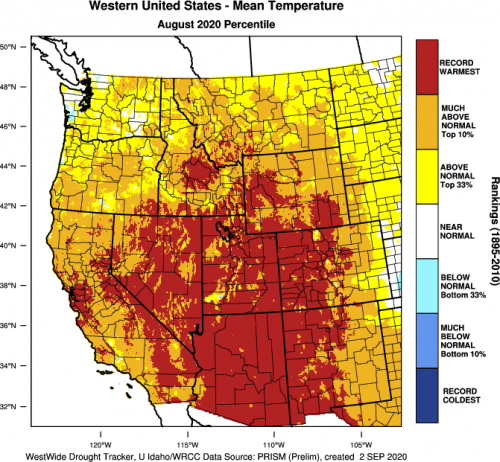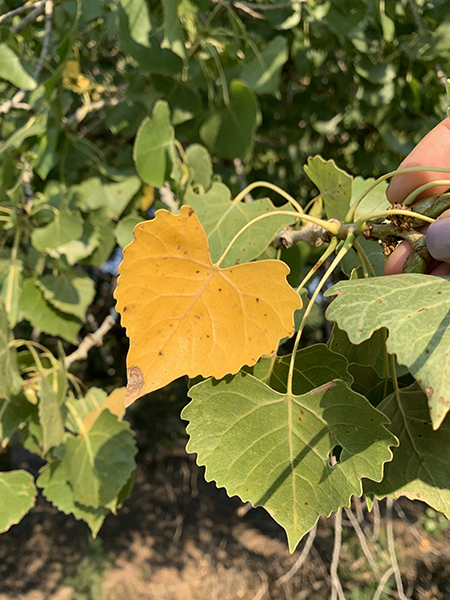September 5, 2020
Leaf Color Changes Remind Us What We Already Know
It’s Been a Long, Hard Summer and Change is Here

Question:
In my yard and around town, I have noticed tree leaves turning yellow in different areas on the tree and falling sporadically. It is primarily older mulberry trees. Is this due to nutrition deficiency, disease, drought, or all of the above?
- J. White, Las Cruces
Answer:
I’ve noticed the same in my own mulberry trees, and my wisteria vines too. I think the prolonged heat and drought are taking their toll, and the stress is observable. Early color change in leaves is a known stress symptom. Last year the bosque up here around Los Lunas flooded for several weeks in June and July, and I was worried that the native golden currant shrubs (Ribes aureum) I’d been tracking might not make it with their roots inundated for so long. As soon as it was dry enough, I went back to check. I was relieved to find that they were still alive and amazed to see that leaves had changed color completely to a deep red in response to the stress. As of yesterday, these same shrubs were still mostly green, with only some leaves showing off their famous fall colors.

As NM State Climatologist Dr. Dave DuBois (@NMClimate) and others have been tweeting all summer, the temperatures and precipitation levels have been both record- and heart-breaking. In a phone conversation with my predecessor Dr. Curtis Smith months ago, he warned that as our climate continues to warm, this summer and in coming years, we should expect many more calls and emails about sickly plants, and pest problems too. Lots of pests and diseases are known to be secondary stressors that strike plants with underlying conditions like water stress.
While walking in the Albuquerque bosque last week, yellowing tips in some cottonwood canopies kept catching my eye. I wondered about the water table levels and how thirsty those giant trees must be. It was so hot that day it was hard to imagine that the seasons are still changing.
In November 2018, I wrote a fun column on fall foliage colors and why tree leaves go straight from green to brown in some years but turn bright gold in others. In that column, I delved into the details, but it all boils down to chemistry and how different plant pigments respond to environmental signals. I wrote: “A general rule is that while temperature tends to affect the intensity of leaf color, it’s the shorter days and longer nights that trigger overall color change.” To find that column and a slew of leaf color photos I’ve collected over recent years, visit the Desert Blooms blog version of my column.
While stress is a good bet as we try to explain yellowing leaves all over, I can’t help but also wonder how much of this color change is a seasonal norm. Time has been incredibly wonky this year. In April, my friend Matt Cohen reflected, “Since COVID started, there are only three days of the week: yesterday, today, and tomorrow.” It’s hard to imagine what the trees were doing at this time last week, let alone last year. During quarantine, people have been much more observant too. How early is this color change compared to other years? Could it be that we are so exhausted from heatstroke and everything else that it just seems too early this year?

I asked Albuquerque BioPark Botanic Garden volunteer Karl Horak what he thought. Horak and a team of dedicated Nature’s Notebook volunteers have been tracking phenology in the bosque throughout recent years. He shared a remarkable graph depicting cottonwood (Populus deltoides) leaf color change observations throughout the state for 2018, 2019, and year-to-date 2020. (I’ll include this graph and others in my blog too!) Horak remarked, “It looks like 2020 is very similar to previous years: a tiny blip or two in the spring (likely aphids), a bigger blip (heat?) in mid-summer, and then the big fall color change starting about now.” I’ll keep you posted as the season—and the data—progress.
Side note: Nature's Notebook is a national, online program with the USA National Phenology Network that uses amateur and professional naturalists to record plant and animal observations in a given location over time. The steps for becoming a volunteer are straightforward. And you can set your backyard as a location or pick a public space and get a group to sign up together—with masks and safe distancing, of course.
At any rate, what a cool relief we had last week across the state. A colleague in Santa Fe said it got down to 39°F one morning. The low temperature at my house on Tuesday was 55°F. The briskness made me giddy, and I briefly considered hanging Christmas lights out by my mailbox to make my neighbors (and myself) laugh. Since then, temps have already rebounded right back up to the high 90s. And forecasts show another expected drop down into the low 40s in a few days (low 50s in southern New Mexico).
Together, we’re learning tough lessons about climate and stress, but also about adaptation and resiliency. Selecting landscape trees and shrubs that can handle each season’s challenges is as difficult as it is important.

Marisa Y. Thompson, PhD, is the Extension Horticulture Specialist, in the Department of Extension Plant Sciences at the New Mexico State University Los Lunas Agricultural Science Center, email: desertblooms@nmsu.edu, office: 505-865-7340, ext. 113.
Links:
For more gardening information, visit the NMSU Extension Horticulture page at Desert Blooms and the NMSU Horticulture Publications page.
Send gardening questions to Southwest Yard and Garden - Attn: Dr. Marisa Thompson at desertblooms@nmsu.edu, or at the Desert Blooms Facebook page.
Please copy your County Extension Agent and indicate your county of residence when you submit your question!